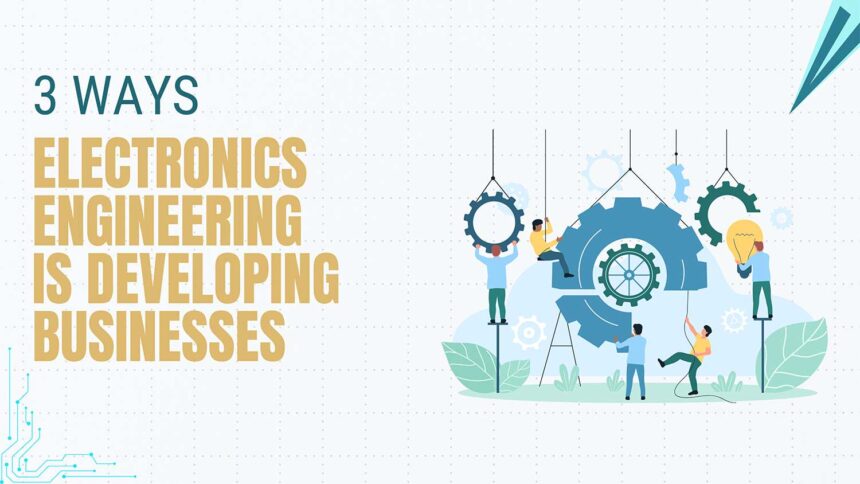One way businesses can innovate is through the application of electronics engineering. Innovation in business means doing things differently to provide more efficient products and solutions and better customer service. Electronics engineering can help with that.
Electronics engineering is essential for everyday business processes and helps companies achieve growth and success if used effectively. Successful businesses do not just view electronics engineering as means to automate processes but also to open up new ways of doing business.
In this article, we’ll explore how electronics engineering is helping to develop businesses.
Use of Robotics
Manufacturing companies are dealing with a wide range of challenges these days, such as the complexity of parts and a significant increase in demand, among others. These challenges have made speed and precision even more important than ever. However, human workers alone cannot keep up with the demands of modern electronics manufacturing, which is why implementing robotics is essential to improving factory workflows.
The arrival of Industry 4.0 had a major impact on the manufacturing industry. It led to the creation of manufacturing robotics that leverage Artificial Intelligence (AI), making them more autonomous than their predecessors. Eventually, these robots will potentially reshape how manufacturing companies in the electronics industry operate.
The improved speed, precision, and consistent performance that modern robotics has made it possible for manufacturers to increase factory throughput. Industrial robots can automate a certain task or workflow, which can speed up existing manufacturing processes and free up workers from several tasks. Some of the most common applications of robotics in the electronics industry include inspecting, palletizing, sealing, gluing, and packaging.
One area in which industrial robotics and process automation can be significantly valuable is testing products. Effective testing is of utmost importance to quality assurance. Finding ways to streamline testing can result in better efficiency in the overall manufacturing process. In some cases, automation can also pave the way for new technologies that can help manufacturers deal with emerging challenges on testing. For instance, the automotive industry is increasingly dependent on monolithic electronic sensors that develop multiple outputs, such as position sensors that offer dual outputs, eliminating the need to install extra sensors in some applications.
Sensors with a single output can be easily tested using common test circuit interfaces. However, sensors that produce multiple outcomes will need to use different hardware. The development of new test circuit interfaces that can test these multi-output sensors can help to ensure that the electronics industry can continue to test sensors without the need to rely on manual solutions.
Protecting Embedded Systems from Malware
Embedded systems security provides mechanisms to keep an embedded system protected from all forms of malicious behaviour, including malware. Embedded systems security is a form of cybersecurity that prevents malicious access to embedded systems. In this type of cybersecurity, specialists will be working with the systems designs team in ensuring that the embedded system is equipped with the necessary security mechanisms to mitigate the damage brought about by malware attacks.
The first step to securing embedded systems is a risk assessment to determine the security requirements. Risk assessment can identify any threats on the system, the possibility of these threats, and the extent of damage they can cause. Aside from conducting risk assessment, a structured approach will be in place to identify and characterise threats leading to a more secure systems design.
A common requirement for embedded systems security is the systematic verification of the security of both software and hardware components within the internal and external supply chain. The program should recognise suppliers that have mature security development processes, such as security-aware manufacturing processes, to minimise the risk of malware attacking the supply chain.
Security plays a major role in keeping the embedded systems protected from all sorts of cyber threats. Therefore, security must be taken into consideration in all stages of the embedded system design instead of bolting it in the later stages. The security and design features of the embedded system security will allow the system to defend, as long as it’s been designed correctly by electronic engineer specialists and protect itself from a wide range of cyber-attacks and mitigate any security challenges.
Implementing Smart Technology
IoT, or the Internet of Things, refers to a network of Internet-enabled objects with sensors, software, and network connections allowing them to connect and exchange data. By implementing these smart devices, companies can improve the productivity of their processes and be more efficient.
Nowadays, many companies invest in smart speakers and voice-enabled applications that allow employees to connect with virtual assistants to get certain tasks done faster. With the help of IoT, companies can increase the efficiency of their workers by freeing up their time from having to perform repetitive tasks, allowing them to focus on more complex tasks. Using voice-enabled smart assistants such as Alexa or Siri is also another way to improve efficiency in the workplace. These smart assistants can be synced with IoT devices to integrate information through custom settings.
Integrating IoT technology capable of connecting devices will make it easier for companies to implement a remote working environment and improve productivity. With these technologies, employees will no longer need to work together with other workers in the office. If your company utilises a shared network, your employees can manage their work outside of the workplace with the help of cloud-hosted software and portable devices. Remember that the best way to enhance employee productivity is integrating IoT-based initiatives into your business processes.
Aside from improving productivity, IoT technologies can also help companies efficiently use their resources and minimise unnecessary expenses. They can use technologies such as intelligent lighting to enhance workflow. It can be programmed to enable motion sensors and determine the user’s schedules.
In addition, artificially intelligent systems like smart thermostats can adjust air conditioning and heating systems, preventing them from overheating while also lowering the cost of electricity. Companies can save more money if they focus on enabling energy conservation through IoT technology.









